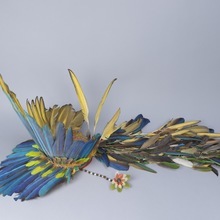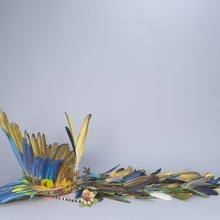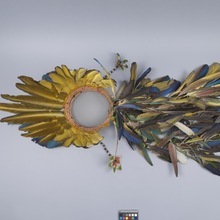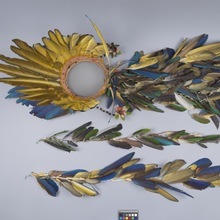Headdress
MOA: University of British Columbia
3010/1 a-c
Headdress of vibrantly coloured macaw, toucan and parrot feathers. Long bright blue feathers create a brim at front of headdress, coming to a point at centre. These are topped by a layer of shorter green and yellow feathers. Above the brim stands a crown of feathers arranged around the circular headband, very tall at front centre and shortening toward sides, lined in front with a set of shorter green and red feathers matching those on the brim. The bark headband is covered with small multicoloured feathers, with red fibre at the bottom. Three tall feathers stand upright on the rear of the headband. Below are tied several long strands of fibre, some threaded with small white glass beads. Intermittently down each strand are attached feathers in various sizes, some in small groupings gathered at their quills by short lengths of palm tubes, as well as elongated, dark brown seeds. Together the strands create a dense layer down the back of the wearer. To both sides of the headband are attached a string of seeds, ending in a flower shape, created by green, white and red feathers.
-
History Of Use
Feather headdresses are a major element of ritual regalia, used during the healing ceremonies of the Kamentsa shamans, as well as for their Carnival ceremony (in which an ancient renewal ritual was adapted onto the Christian calendar event).
- Type of Item headdress
- Culture Kamentsa
- Material toucan feather, parrot feather, macaw feather, glass, palm fibre, wool fibre, seed, bark
- Measurements height 46.5 cm, width 50.5 cm, depth 128.0 cm (overall)
- Creator Basilio Juajibioy
- Previous Owner Diego Samper, Marlene Samper
- Received from Diego Samper, Museum of Anthropology Director's Budget
- Made in Putumayo
- Creation Date before 1989
- Collection Date during 1989
- Ownership Date before August 4, 2013
- Acquisition Date on August 4, 2013
- Condition fair
- Accession Number 3010/0001 a-c



